Horn Book Fanfare 2013
Please see below our annual Fanfare list, the Horn Book’s choices for the best books published for children and teens in 2013.

Please see below our annual Fanfare list, the Horn Book’s choices for the best books published for children and teens in 2013. We compile the list via an ongoing discussion among ourselves and with our reviewers, winnowing down the several hundred books the Horn Book Magazine highly recommended through the year to a relatively modest handful of thirty. As with any such list, people will, and people should, ask why these books and not those books? Why these thirty? I can only tell you how I voted: I looked for books that at once surprised me and convinced me of their necessity, books that made me glad they were here. Here’s hoping that at least a few of our choices give you the same happiness.

Roger Sutton
Editor in Chief
Picture Books
 Building Our House
Building Our Housewritten and illustrated by Jonathan Bean; Farrar
(Primary)
Here is a picture book as carefully constructed as its subject — with step-by-step building instructions, harmonious (and humorous) interplay between text and image, varied page layouts, and eye-catching details in the warm watercolor-wash art. Bean’s own childhood memories inform this heartwarming story about a family who is building not just a house but a home. Review 1/13.
 Journey
Journeywritten and illustrated by Aaron Becker; Candlewick
(Primary)
In this wordless tour de force, a lonely little girl draws her way (à la Harold and the Purple Crayon) into a world full of adventure, heroic rescues, and harrowing escapes — and back again, where she finds a like-minded friend. Becker’s luminous, richly detailed watercolors are a feast for readers’ eyes and imaginations. Review 9/13.
 Mr. Tiger Goes Wild
Mr. Tiger Goes Wildwritten and illustrated by Peter Brown; Little, Brown
(Preschool, Primary)
Mr. Tiger, clad in top hat and bow tie, looks the part in high society. But this cat is restless, and soon his animal nature claws its way out — ROAR! Brown’s be-yourself celebration, with its spare text, spot-on pacing, and bold mixed-media illustrations, is perfectly pitched to a wild-child audience. Review 11/13.
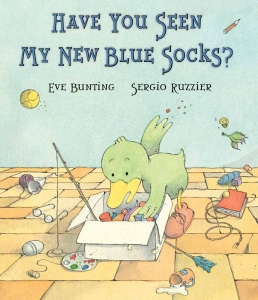 Have You Seen My
New Blue Socks?
Have You Seen My
New Blue Socks?written by Eve Bunting, illustrated by Sergio Ruzzier; Clarion
(Preschool, Primary)
“I have lost my new blue socks. / Have you seen them, Mr. Ox?” With the help of his friends, Duck — a Noodlehead character if there ever was one — searches for his lost socks in this child-centered, funny, read-it-again picture book. Bunting’s jaunty Seuss-inspired rhyming text is a seamless match for Ruzzier’s sweetly surreal illustrations. Review 3/13.
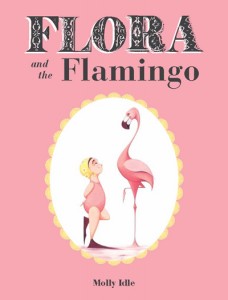 Flora and the Flamingo
Flora and the Flamingowritten and illustrated by Molly Idle; Chronicle
(Preschool, Primary)
A little girl first imitates, then annoys, then wins over, then duets with a ballet-dancing flamingo. Abundant white space, framed by delicate cherry blossoms, plays up the pair’s graceful lines; pull-down flaps highlight the wordless story’s physical comedy and rhythmic pacing. The joyful (if not-so-graceful) grand finale will have readers shouting, “Encore!” Review 7/13.
 The Tiny King
The Tiny Kingwritten and illustrated by Taro Miura; Candlewick
(Preschool)
Pictured “actual size” on the cover, the nine-inch-tall King has more than any one person could want (or manage!), which is his problem. But a Big Queen and their ten children make the palace a far less lonely place. Simple geometric shapes in strong colors add ebullience to a story — and a King — that has everything. Review 11/13.
 Niño Wrestles the World
Niño Wrestles the Worldwritten and illustrated by Yuyi Morales; Porter/Roaring Brook
(Preschool, Primary)
Pint-sized luchador Niño, clad in a bright red mask and tighty whities, bests foes from Mexican folklore. Ultimately, he’s done in by his tiniest (and real) competitors: las hermanitas. Morales packs a mighty punch with her high-energy text (sprinkled with Spanish words and sound effects) and her vivid digital collage illustrations. Review 7/13.
 The Dark
The Darkwritten by Lemony Snicket, illustrated by Jon Klassen; Little, Brown
(Preschool, Primary)
The dark lives in the same house with Laszlo, who is afraid of it. When the dark visits Laszlo’s bedroom, the boy ventures into the basement — where even a flashlight can’t aid him — and discovers a rational solution to his fear. Klassen’s expert use of line, angle, and contrast, plus a striking monochromatic palette, convey the essence of Snicket’s clever story about a universal anxiety. Review 3/13.
 Mr. Wuffles!
Mr. Wuffles!written and illustrated by David Wiesner; Clarion
(Preschool, Primary)
Mr. Wuffles is intrigued by a new toy — actually, a tiny spaceship. When his feline batting and pouncing damages it, the little green aliens inside join up with the household’s insect civilization to repair the ship and thwart the cat. This exemplary almost-wordless book incorporates the delights of Borrowers-style innovations, quintessential cat behavior, and Wiesner’s witty, precise art. Review 9/13.
 Gobble You Up!
Gobble You Up!written by Gita Wolf, illustrated by Sunita; Tara
(Preschool, Primary)
In this exuberant adaptation of a Hindi tale from Rajasthan, greedy Jackal gulps down animal after animal — until he bursts! The gorgeous, tactile, stylized illustrations in bold flat black and crisp white (done in a traditional Meena style of art passed from mothers to daughters) have been meticulously hand-silkscreened onto sturdy kraft paper and hand bound. A true work of art. Review 1/14.
Fiction
 All the Truth That’s in Me
All the Truth That’s in Mewritten by Julie Berry; Viking
(High School)
Judith is mute following her return to her Puritan-esque village (named Roswell Station) after a traumatic two-year period of captivity. Readers gradually learn “all the truth” about her as she speaks in her head to her true love, Lucas. Berry’s superb, poetic writing propels this harrowing tale — part murder mystery, part search for identity, part thrilling romance. Review 11/13.
 Penny and Her Marble
Penny and Her Marblewritten and illustrated by Kevin Henkes; Greenwillow
(Primary)
“The Tell-Tale Heart” for the emerging reader set. Penny takes something (a beautiful blue marble) that doesn’t belong to her; beset by guilt, she returns it. Through natural language, concrete imagery, impeccable pacing, and expressive illustrations, Henkes explores — thoughtfully, respectfully, and without a hint of didacticism — a common crisis of childhood. Review 3/13.
 The Year of Billy Miller
The Year of Billy Millerwritten and illustrated by Kevin Henkes; Greenwillow
(Primary, Intermediate)
This reassuring book is divided into four parts, each with a focus on second-grader Billy and someone in his life — Teacher, Father, Sister, Mother. Billy is unsure about whether he’s smart enough for school; through small, confidence-building vignettes, he gratifyingly comes into his own. Nuanced and human, accessible and engaging, it’s a perfect snapshot of a primary-grader’s year. Review 9/13.
 Bo at Ballard Creek
Bo at Ballard Creekwritten by Kirkpatrick Hill, illustrated by LeUyen Pham; Holt
(Primary, Intermediate)
This could almost be Little House in the Mining Camp, save for the fact that little Bo has a livelier time of it, what with her two miner-fathers and a host of colorful, occasionally inebriated, neighbors. Hill’s evocation of the 1920s Alaska setting is never quaint, and Bo’s exploits are mountains of fun. Review 5/13.
 The Thing About Luck
The Thing About Luckwritten by Cynthia Kadohata, illustrated by Julia Kuo; Atheneum
(Intermediate, Middle School)
Twelve-year-old Japanese-American Summer and her younger brother Jaz head out “on harvest” with their grandparents — Jiichan to drive a combine, Obaachan to cook for the crew, with Summer as her assistant. Kadohata displays her deft hand with characterization and setting in this poignant, funny, and insightful coming-of-age novel set in the contemporary Midwest. Review 7/13.
 Far Far Away
Far Far Awaywritten by Tom McNeal; Knopf
(Middle School, High School)
The ghost of Jacob Grimm narrates a tale filled with menace and horror, buoyancy and light. Jacob acts as mentor to teen Jeremy Johnson Johnson, whose life is threatened by the Finder of Occasions, a malevolent force hiding in plain sight in Jeremy’s small town. A unique — and mesmerizing — blending of Grimm archetypes and tropes with a story of modern-day evil and coming-of-age. Review 7/13.
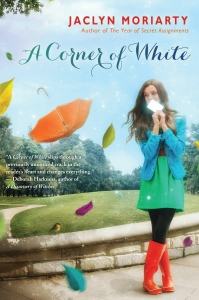 A Corner of White
[Colors of Madeleine]
A Corner of White
[Colors of Madeleine]written by Jaclyn Moriarty; Levine/Scholastic
(Middle School, High School)
“Help me! I am being held against my will!” reads a scrap of paper stuck in a parking meter. Thus begins a communiqué between Madeleine, who lives in England, and Elliot, from the Kingdom of Cello (he didn’t write the note, but that comes later). A tantalizingly complex, frequently humorous, thoroughly original fantasy. Review 5/13.
 Invasion
Invasionwritten by Walter Dean Myers; Scholastic
(Middle School, High School)
Woody is nineteen in 1944, and we’re with him every slogging step of the way in the water, on the beach, and through the woods as the 29th Infantry joins in the D-Day assault on Omaha Beach. Myers intensely evokes the experience of combat to allow readers a larger consideration of war. Review 11/13.
 Bluffton: My Summers with Buster
Bluffton: My Summers with Busterwritten and illustrated by Matt Phelan; Candlewick
(Intermediate)
In 1908, a boy falls under the spell of the vaudevillians who summer in his small, usually uneventful Michigan town, including young Buster Keaton: his pratfalls and pranks, his love of baseball, his unrestricted life. Phelan’s graphic novel is spellbinding in its own right, with a cinematic sweep and comic timing ideally suited to its subject. Review 11/13.
 Eleanor & Park
Eleanor & Parkwritten by Rainbow Rowell; St. Martin’s Griffin
(High School)
New girl Eleanor and loner Park are an unlikely pair, yet their relationship slowly evolves in a way that is heart- tuggingly intimate, authentically awkward, and ultimately life-changing. Rowell relates her characters’ intense romance through compelling alternating narration sprinkled with 1980s references. Unforgettable. Review 5/13.
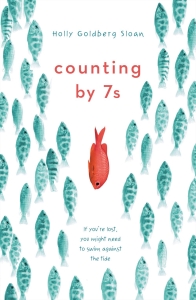 Counting by 7s
Counting by 7swritten by Holly Goldberg Sloan; Dial
(Middle School)
After her parents’ death, twelve-year-old Willow Chance is taken in by her new friend Mai Nguyen’s mother, Pattie (née Dung). A good-hearted cabdriver, a sad-sack school counselor, and Mai’s surly brother round out the eclectic, multicultural cast. The story’s resolution — idealized though it may be — restores readers’ faith in human kindness. Review 9/13.
 P.S. Be Eleven
P.S. Be Elevenwritten by Rita Williams-Garcia; Amistad/HarperCollins
(Intermediate, Middle School)
This sequel to One Crazy Summer (rev. 3/10) begins with Delphine and her sisters making a “grand Negro spectacle” of themselves and catching Big Ma’s wrath. In Bed-Stuy, Pa has a “lady friend”; Uncle Darnell is back, changed, from Vietnam; and the Jackson Five are burning up the charts. A funny, wise, poignant, and thought-provoking book. Review 5/13.
 Boxers & Saints
Boxers & Saintswritten and illustrated by Gene Luen Yang, color by Lark Pien; First Second/Roaring Brook
(Middle School, High School)
Trust Gene Luen Yang to find the humor — as well as the adventure and historical significance — in China’s Boxer Rebellion. The two volumes of the graphic novel allow Yang to present different perspectives on the era, both infused with a matter-of-fact magical realism to bring the mythic and spiritual dimensions of the Rebellion to the fore. Review 9/13.
Nonfiction
 On a Beam of Light: A Story of Albert Einstein
On a Beam of Light: A Story of Albert Einsteinwritten by Jennifer Berne, illustrated by Vladimir Radunsky; Chronicle
(Primary)
“The biggest, most exciting thought Albert ever had” is the focus of this homage to the great physicist. Berne’s text captures Einstein’s curious nature and constant sense of wonderment, while Radunsky’s illustrations — loose, motion-infused pen-and-ink lines on textured paper — embody the feeling of “racing through space on a beam of light.” Review 5/13.
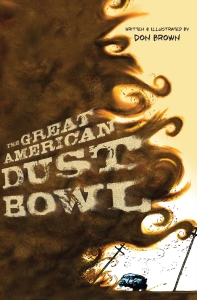 The Great American Dust Bowl
The Great American Dust Bowlwritten and illustrated by Don Brown; Houghton
(Middle School, High School)
Brown’s gripping graphic-novel treatment of the catastrophic 1930s Dust Bowl captures its misery and consequences through pictures that heighten the drama and carry the narrative. A varied layout and occasional use of visual metaphor (“Enough dust to fill 1,500 modern supertankers blew east”) balance the stark realism of the pictures and the (necessarily) mostly brown palette. Review 11/13.
 Look Up!: Bird-Watching in Your Own Backyard
Look Up!: Bird-Watching in Your Own Backyardwritten and illustrated by Annette LeBlanc Cate; Candlewick
(Intermediate)
“Bird-watching is NOT boring!” Even skeptical readers will agree after spending time with this detailed, engaging introduction to the hobby, illustrated with cheery cartoon drawings. Replete with silly jokes and asides, the text is accessible and scientifically sound. Bird-watching can happen anywhere, anytime, and this book allows readers’ imaginations to fly. Review 5/13.
 Locomotive
Locomotivewritten and illustrated by Brian Floca; Jackson/Atheneum
(Primary, Intermediate)
“CLANG-CLANG CLANG-CLANG”; “WHOO-OOOOOO.” Floca captures the epic sweep of the Western landscape and the grandeur of the locomotive while telling a smaller story of one family’s 1869 cross-country railroad journey. Breathtaking panoramic spreads are juxtaposed with intimate, slice-of-life spot art (we even see the train’s toilet) in this spectacular, informative, immediate picture book. Review 9/13.
 The Animal Book: A Collection of the Fastest, Fiercest, Toughest, Cleverest, Shyest — and
Most Surprising — Animals on Earth
The Animal Book: A Collection of the Fastest, Fiercest, Toughest, Cleverest, Shyest — and
Most Surprising — Animals on Earthwritten and illustrated by Steve Jenkins; Houghton
(Primary, Intermediate, Middle School)
Images from Jenkins’s many innovative books about the natural world are here put to ingenious new use as the author-artist surveys the history and breadth of the animal kingdom through thematic chapters. Creatively figured charts and graphs are as eye-catching as the true-to-life collage art; back matter is exemplary. Review 1/14.
 March: Book One
March: Book Onewritten by John Lewis and Andrew Aydin, illustrated by Nate Powell; Top Shelf Productions
(Middle School, High School)
This graphic novel autobiography, first in a projected trilogy, is a vivid account of civil rights leader Lewis’s early life, from his boyhood as an Alabama sharecropper’s son to his crucial role in desegregating Nashville’s lunch counters. The power of the story combines with a clear trajectory in text and black-and-white-paneled page layout to create a wholly involving, you-are-there experience. Review 1/14.
 Scaly Spotted Feathered Frilled: How Do We Know What
Dinosaurs Really Looked Like?
Scaly Spotted Feathered Frilled: How Do We Know What
Dinosaurs Really Looked Like?written by Catherine Thimmesh; Houghton
(Intermediate)
Another dinosaur book? Not exactly: rather than adding to the panoply of dino-guides, Thimmesh instead looks at how new discoveries in paleontology require sometimes-drastic revisions by paleoartists. Is that a job? Yes! Copious illustrations by leading artists add much appeal to the book’s unique approach. Review 9/13.
From the January/February 2014 issue of The Horn Book Magazine. For previous years' Fanfare lists, click on the tag Fanfare list.
says
Add Comment :-
RELATED
RECOMMENDED
ALREADY A SUBSCRIBER? LOG IN
We are currently offering this content for free. Sign up now to activate your personal profile, where you can save articles for future viewing.







